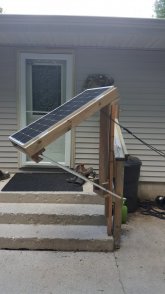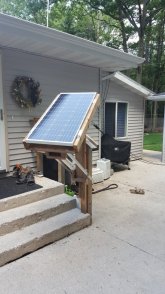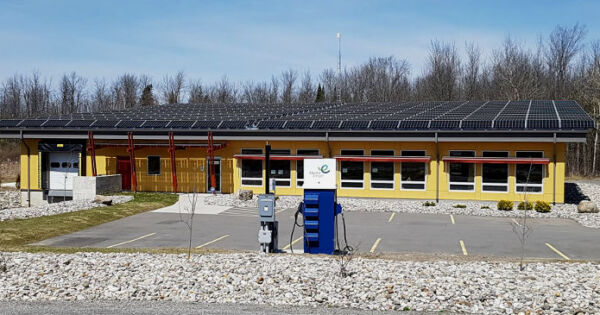HARG Hunter
Thirsty for Off-Grid Knowledge
We just built our cabin from the ground up.
Concrete slab, 24' x 32' cabin.
The cabin is wired for standard 120v AC current.
Solar Panels: (3) Renogy 100w/12v panels wired in parallel. (Partially wooded area, so we want panels to be separate)
Charge Controller: Renogy Rover Elite 20a MPPT (Connected to panels with 10awg cable)
***Info Below Updated 7-24-23***
Battery Bank: (1) CHINS 12v 200ah LiFePO4 - Connected to the charge controller with 10awg cable. Battery-to-Battery cable is 2awg.
Inverter: Giandel 1500w Pure Sine Wave - 200a inline fuse on positive)
It is wired for 2 circuits:
Circuit #1:
(3) Duplex Outlets that also have USB receptacles for us to charge phones/laptops.
(5) LED recessed lights. 3 of them are 5w, and 2 of them (Outdoor) are 7.2w
Total load on this circuit should be 100w assuming all 5 lights are on, 3 phones are being charged and 2 laptops are being charged.
Circuit #2:
(3) Duplex outlets that are used for misc needs. 1 outlet is for the TV (32" LED TV that only draws 58w
(2) Ceiling Fans with LED lights. (Primarily used at night on low to circulate heat in the winter). Fan draws 50w
(1) Bathroom exhaust fan w/LED Light. Draws 17w
Water Pump:
We have a 12v Water Pressure pump directly connected to the battery bank with a power switch.
This pressures our PEX water supply pipes with water which is drawn from a rain water collection system hooked up to our gutters outside.
Based on projected usage for each light & appliance, we expect to use approx. 1200-1300w per day.
Each circuit terminates to the battery box with a 10ga extension cord plug. (See the "Circuit Connections" photo.
We can plug both circuits into the 1000w Inverter, plug both into the Generator receptacles, or 1 each if we wish.
Inside the battery bank "box" you can see (2) extension cords coming out of the wall. The close-up photo shows in that configuration that we have Circuit #1 plugged into the inverter, and Circuit #2 hooked up to the generator. This gives us flexibility to power the cabin to fit the situation.
In summer, we can run the lights off of the inverter and run a window AC unit off of the generator etc...
This is a young system, so we are still tweaking things, but so far it has worked well, especially giving us the flexibility to run the cabin off of a generator when we are there for longer periods of time or are running high-powered tools.
Current Set-Up cost is approx. $1900
Misc Notes:
Panels are mounted with an adjustable system I made. The frames they are mounting to are treated lumber. The frame is attached to the post with a hinge. The face face our solar south, but the angle is adjustable for each month of the season with holes drilled in aluminum angle iron. I looked up the angles for each month required based on our location her: SOLAR ANGLE CALCULATOR Just scroll down and enter your country, state and approx. nearest city and you're given the angles for each month. I took those angles, simply had my wife move the frame while it was on it's hinge, and marked the angle iron for the drill holes.
All I have to do to adjust the angle is loosen (2) wingnuts, move the brackets to the desired month, and re-tighten the wing nuts. See the "Solar Mounting System" photo for reference. That was when it was only a 2-Panel system, but the angle adjustment system di not change. The adjustable mounting system probably cost me $75 in lumber, angle iron and hardware.
While I'm still learning (Thanks to many members here. You know who you are!), I feel I final have a handle on the system, and it has allowed us to have everything we need in a central Wisconsin off grid hunting cabin. We are able to have more than the essential power we need to be very comfortable instead of roughing it like we used to.
The power company wants $16,000 just to bring power to this location, and that would not include hardware. Plus we'd have a monthly electric bill.
Instead, in the end we'll have spent under $2000 to be energy independent!
Again, I'm no expert, but if you are looking for a similar set-up, I can certainly help you get started if you need someone to help explain things in terms you can understand.
Concrete slab, 24' x 32' cabin.
The cabin is wired for standard 120v AC current.
Solar Panels: (3) Renogy 100w/12v panels wired in parallel. (Partially wooded area, so we want panels to be separate)
Charge Controller: Renogy Rover Elite 20a MPPT (Connected to panels with 10awg cable)
***Info Below Updated 7-24-23***
Battery Bank: (1) CHINS 12v 200ah LiFePO4 - Connected to the charge controller with 10awg cable. Battery-to-Battery cable is 2awg.
Inverter: Giandel 1500w Pure Sine Wave - 200a inline fuse on positive)
It is wired for 2 circuits:
Circuit #1:
(3) Duplex Outlets that also have USB receptacles for us to charge phones/laptops.
(5) LED recessed lights. 3 of them are 5w, and 2 of them (Outdoor) are 7.2w
Total load on this circuit should be 100w assuming all 5 lights are on, 3 phones are being charged and 2 laptops are being charged.
Circuit #2:
(3) Duplex outlets that are used for misc needs. 1 outlet is for the TV (32" LED TV that only draws 58w
(2) Ceiling Fans with LED lights. (Primarily used at night on low to circulate heat in the winter). Fan draws 50w
(1) Bathroom exhaust fan w/LED Light. Draws 17w
Water Pump:
We have a 12v Water Pressure pump directly connected to the battery bank with a power switch.
This pressures our PEX water supply pipes with water which is drawn from a rain water collection system hooked up to our gutters outside.
Based on projected usage for each light & appliance, we expect to use approx. 1200-1300w per day.
Each circuit terminates to the battery box with a 10ga extension cord plug. (See the "Circuit Connections" photo.
We can plug both circuits into the 1000w Inverter, plug both into the Generator receptacles, or 1 each if we wish.
Inside the battery bank "box" you can see (2) extension cords coming out of the wall. The close-up photo shows in that configuration that we have Circuit #1 plugged into the inverter, and Circuit #2 hooked up to the generator. This gives us flexibility to power the cabin to fit the situation.
In summer, we can run the lights off of the inverter and run a window AC unit off of the generator etc...
This is a young system, so we are still tweaking things, but so far it has worked well, especially giving us the flexibility to run the cabin off of a generator when we are there for longer periods of time or are running high-powered tools.
Current Set-Up cost is approx. $1900
Misc Notes:
Panels are mounted with an adjustable system I made. The frames they are mounting to are treated lumber. The frame is attached to the post with a hinge. The face face our solar south, but the angle is adjustable for each month of the season with holes drilled in aluminum angle iron. I looked up the angles for each month required based on our location her: SOLAR ANGLE CALCULATOR Just scroll down and enter your country, state and approx. nearest city and you're given the angles for each month. I took those angles, simply had my wife move the frame while it was on it's hinge, and marked the angle iron for the drill holes.
All I have to do to adjust the angle is loosen (2) wingnuts, move the brackets to the desired month, and re-tighten the wing nuts. See the "Solar Mounting System" photo for reference. That was when it was only a 2-Panel system, but the angle adjustment system di not change. The adjustable mounting system probably cost me $75 in lumber, angle iron and hardware.
While I'm still learning (Thanks to many members here. You know who you are!), I feel I final have a handle on the system, and it has allowed us to have everything we need in a central Wisconsin off grid hunting cabin. We are able to have more than the essential power we need to be very comfortable instead of roughing it like we used to.
The power company wants $16,000 just to bring power to this location, and that would not include hardware. Plus we'd have a monthly electric bill.
Instead, in the end we'll have spent under $2000 to be energy independent!
Again, I'm no expert, but if you are looking for a similar set-up, I can certainly help you get started if you need someone to help explain things in terms you can understand.
Attachments
-
 Panels (Behind).jpg136.5 KB · Views: 105
Panels (Behind).jpg136.5 KB · Views: 105 -
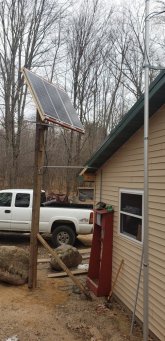 Panels (Front).jpg166.1 KB · Views: 100
Panels (Front).jpg166.1 KB · Views: 100 -
 External Power Inputs.jpg63.2 KB · Views: 110
External Power Inputs.jpg63.2 KB · Views: 110 -
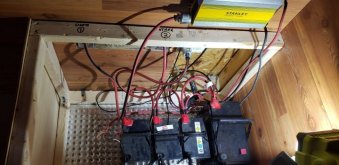 Battery Bank.jpg65 KB · Views: 113
Battery Bank.jpg65 KB · Views: 113 -
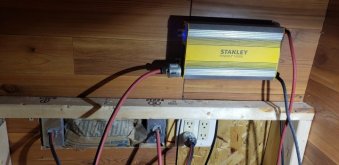 Circuit Connections.jpg51.4 KB · Views: 114
Circuit Connections.jpg51.4 KB · Views: 114 -
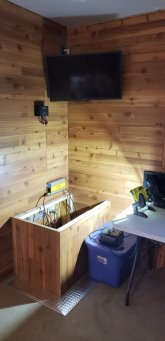 Set Up from a Distance.jpg72 KB · Views: 102
Set Up from a Distance.jpg72 KB · Views: 102 -
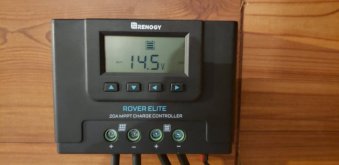 Renogy Rover Elite 20a MPPT.jpg31.6 KB · Views: 106
Renogy Rover Elite 20a MPPT.jpg31.6 KB · Views: 106 -
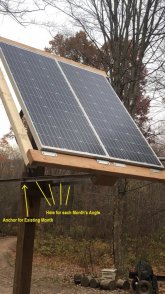 Solar Mounting System.jpg183.7 KB · Views: 108
Solar Mounting System.jpg183.7 KB · Views: 108
Last edited:



